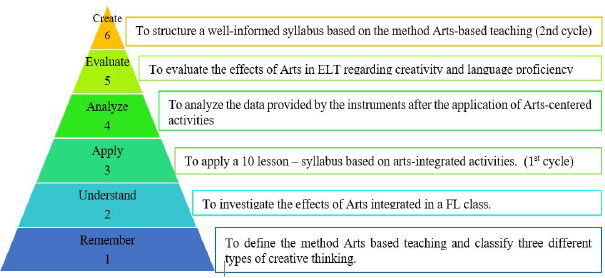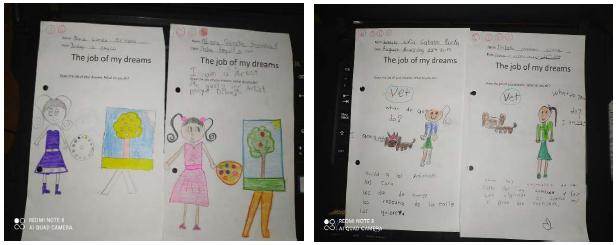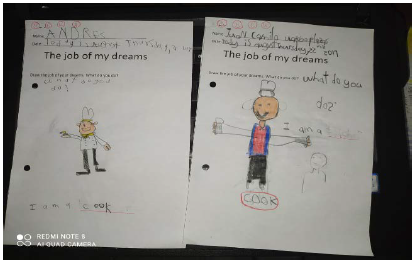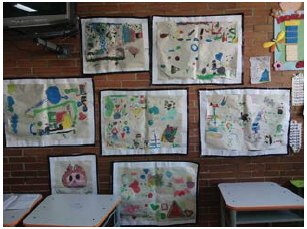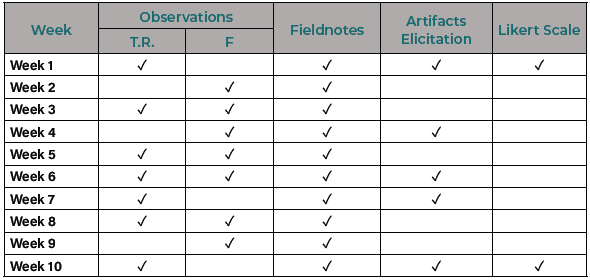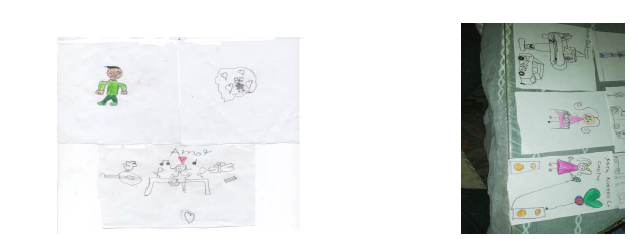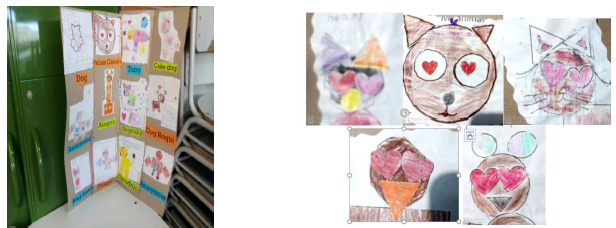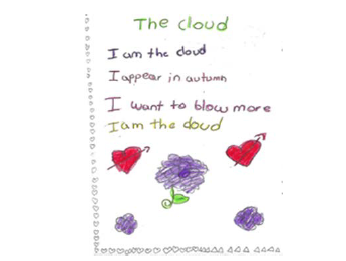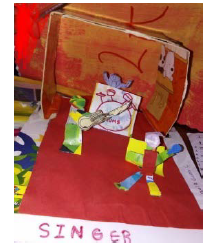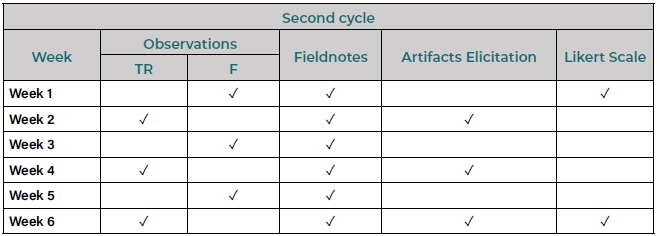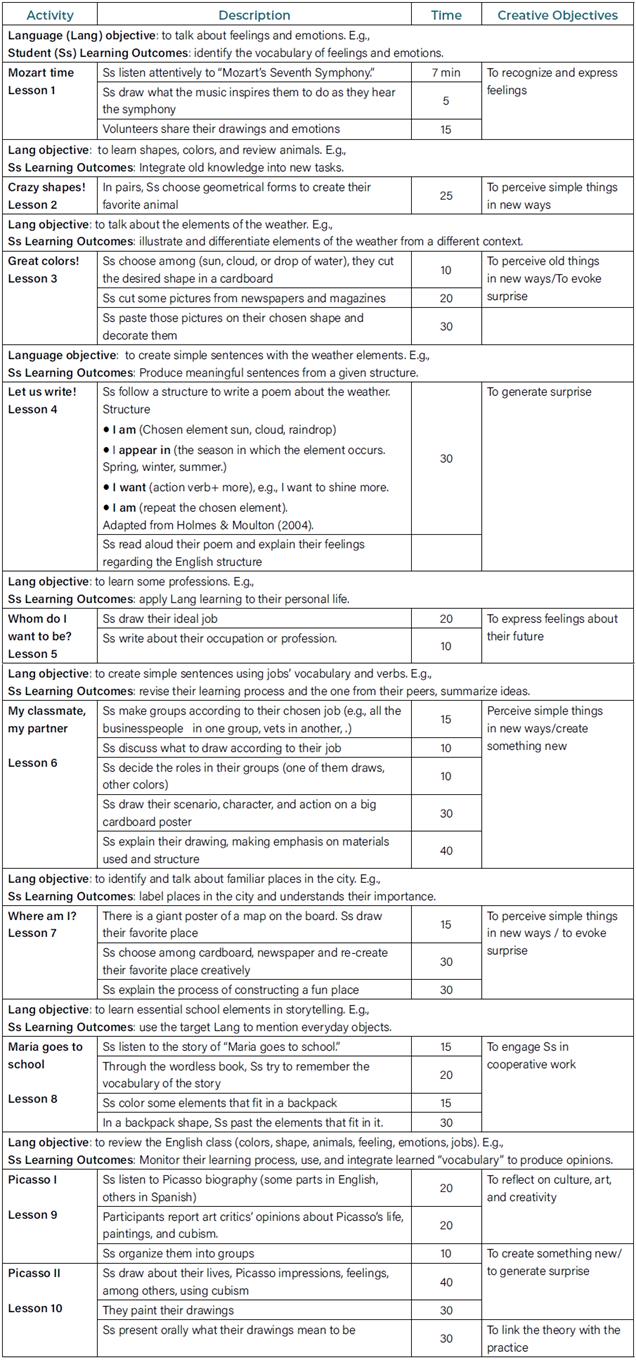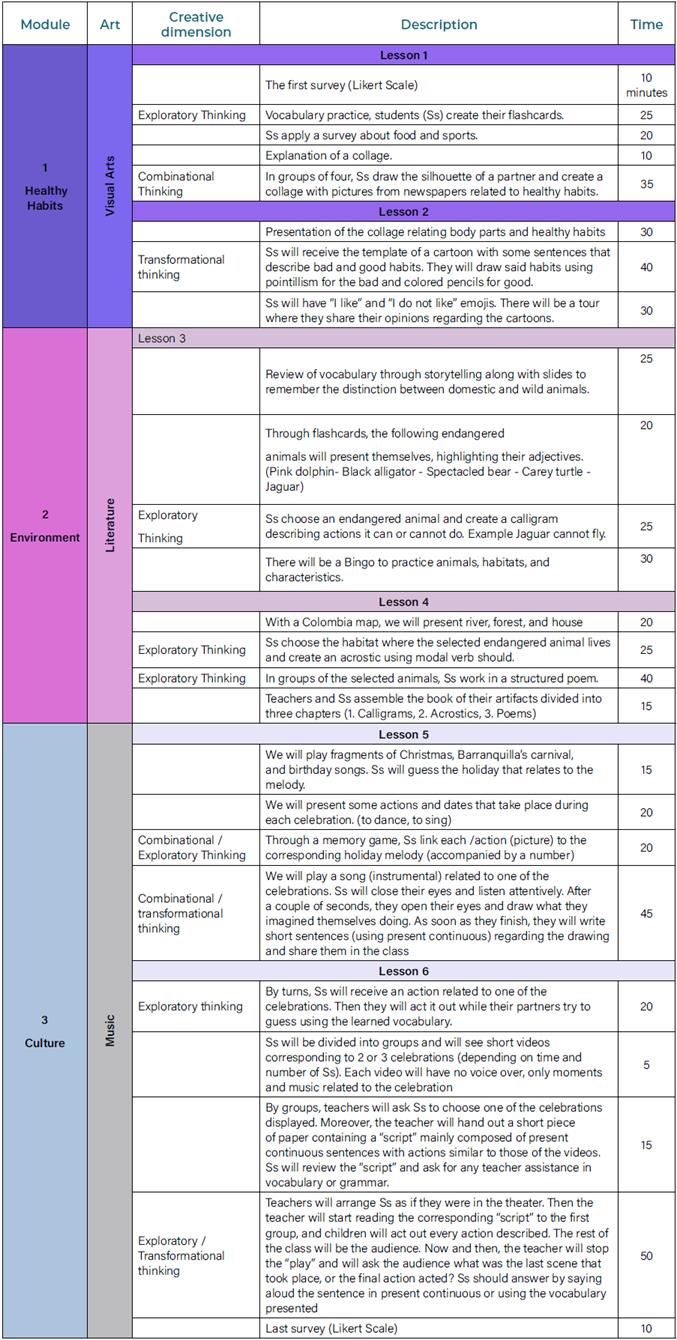INTRODUCTION
Language education comprehends a variety of methods and approaches that stress comprehension, contextualization, and communication. Chi (2017) claims that "traditional English teaching methods cannot address the needs of current students who have a desire for creative and meaningful education" (P. 1). Therefore, Arts-Based Teaching, the purposeful use of artistic skills, processes, and experiences to foster learning in non-artistic disciplines and domains, can contribute to creativity. The authors noted that the arts receive little recognition in teaching, and some schools seem unaware of their potential, despite the widespread practices with images, songs, or literature.
There is some recent literature on the connection between Arts-Based Teaching (A.B.T.) and creativity, an essential 21st-century skill. Arts integration, which means "using different art forms like visual arts, dance, music, and drama to promote EFL learners to learn English meaningfully" (Chi, 2017, p. 4), is a method for innovating in the second language acquisition (SLA). Smithrim & Upitis (2005), citing Oreck (2002), Reimer (1970), and Iwai (2002), believe that fine arts can meet students' needs regarding creativity. It can improve students' aesthetic, socio-emotional, socio-cultural, cognitive skills, and academic development. Nevertheless, over the past century, the arts supported pedagogy.
Furthermore, the integration of arts in the EFL classroom contributes to resourcefulness and ingenuity. For instance, Tin (2013) discusses how E.L.T. should not limit itself to expressing known ideas but original ones by transforming regular tasks into creative ones. For Birgili (2015), creativity development deals with synthesis, articulation, and imagination to prompt analysis and open-mindedness. Birgili (2015) proposes three dimensions of creative thinking which we complemented with Tin's (2013) categories. First, the Combinational Thinking/Articulation Dimension deals with producing ideas or knowledge by combining new and old concepts. Second, the Exploratory Thinking/Synthesis Dimension helps determine the possibilities through analogous thinking using small existing rules. Finally, the Transformational Thinking/Imagination Dimension significantly alters current space rules while connecting reliable thoughts.
In line with the literature reviewed, this inquiry positively impacted how children exercise and enhance their creativity while acquiring another language (L2). Therefore, we seek to respond to two questions: How can Arts-Based Teaching foster creativity in an L2 class? and What is the impact of Arts-Based Teaching on language development? For doing so, we analyzed the effects of the method Arts in ELT on creativity through artifact elicitation. This paper describes the problem evidenced at the school, the research method, and the data collection instruments. It explains the pedagogical intervention process and discusses the results found, organized according to each of the research questions. The article closes with the discussion, suggestions for further research on the method, and pedagogical implications. For the sustainability of the project, the authors conducted a second cycle when on-site classes started.
METHODOLOGY
The authors opted for a qualitative methodology to discuss "how people interpret their experiences, how they construct their worlds, and what meaning they attribute to their experience" (Merriam & Tisdell, 2016). The qualitative aspects of the inquiry were appropriate because arts link experiences (e.g., aesthetical, spiritual, academic) to practice. On the other hand, action research was about what practitioners did in practice (Bradbury, 2010). Action research allowed us to take ownership of teaching since we worked directly with the pupils without the headteachers as intermediaries (O'Connor, Greene, & Anderson (2006). We saw the necessity to structure a syllabus drawing on theories, literature, research reports our diagnosis, and the results of our study. Bloom's Taxonomy guided the formulation of objectives and methodology (see Figure 1)
This should be changed for: The study took place at a school located in the northwest of Bogotá with the participation of two second-grade groups of 35 boys and girls between 7-9 years old. Research cycle took ten sessions in blocks of 100 minutes.
The authors identified problems of lack of creativity and innovation. The headteacher had difficulties getting pupils' attention. Often, they started an assignment but ended up doing unrelated activities such as chatting, playing, or even walking around the room. The excerpts from teachers' observations before and during the practicum exemplify the problem.
Authors' Journal entry # 1. Students are very demotivated; they are always looking up to the sky or through the window. One of them is creating a false gun and "shooting his partners," two girls are gossiping, and another is eating. Few are paying attention.
While some of them participate as per the teacher's request, the rest tend to get distracted. (...) The children sitting at the back get distracted easily, either by talking to other partners or looking outside the classroom.
Authors' Journal entry # 6. Students do not know how to listen to others, they want to speak all the time, but they do not care about other students' reflections or stories. There was confusion trying to listen; some laughed at their classmates. Others were not motivated because they did nothing during vacations. The ones that already participated are doing different things, is difficult to maintain their attention.
We also could mark a lack of innovation and creativity in the children's productions. This led to low attention spans and disengagement convincing us of the need to introduce tasks that required more than a reproduction of language patterns (Figures 2 and 3) but demanded creativity.
There were repetitive tasks that did not prompt communicative or critical thinking skills, which would affect second graders' engagement. We found the situation worrying since the skills mentioned show a connection to human beings' integral development.
The authors found a gap while revising the literature and recent research studies. There is scarce documentation on the A.B.T. to inform the structuring of an L2 syllabus. On the other hand, there is no apparent connection between A.B.T. with creative development. Further studies should conceptualize Art-Based Teaching supported by empirical evidence. Table 1 offers readers a description of the research procedures and instruments that the authors used to address the problem identified and fill the literature gap.
Table 1 Description of the research procedures and instruments
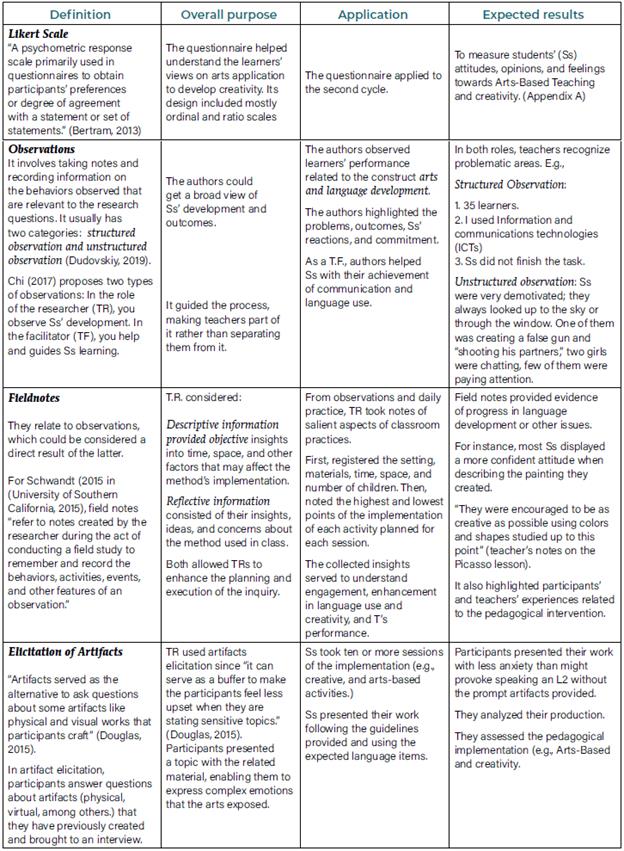
Note. Students presented their insights and used the L2 tacklend in this task
After five months, we implemented Arts-Based Teaching tasks for they provide creative and critical-inducing thought. The unit of analysis was the artifacts created by participants/artistic and communicative outcomes which included posters, paintings, drawings, and written texts, among others that were shared. Table 2 describes the timeline.
Our proposal's vision of the curriculum is "what actually goes on from moment to moment in the language classroom" (Nunan cited in Tudor, 2001, p. 29). It sets objectives, and the classroom is where we pursue these objectives in a controlled and focused manner. Thus, our first cycle syllabus (see Appendix B) comprises ten lessons. Each class describes procedures, the average time of the activities, the objectives regarding creativity, language, and the outcomes.
After implementing the first syllabus, we created the second cycle program (see Appendix C) based on preliminary results and data analysis. It took into account the Ministerio de Educación Nacional (M.E.N) guidelines, standards (M.E.N, 2006), and the suggested curricula (M.E.N, 2016). The syllabus contains three modules, each one divided into two lessons for a total of six sessions. Each class was built on prior knowledge with a sequential organization so that every task becomes purposeful. The chart displays first, the leading art form used in each module. Then, it shows the creative dimension, and third, a general description of each task and time.
PRELIMINARY RESULTS
The organization of the preliminary results revealed two categories. The first answered how Arts-Based Teaching fostered creativity in three creative dimensions: combinational, exploratory, and transformational thinking. The second related to the positive impact of the method and creativity engagement on tutees' language development.
ARTS-BASED TEACHING FOSTERED CREATIVE DIMENSIONS
Combinational Thinking. Lessons 1, 2, 6, and 7 demonstrated how the children expanded or produced ideas by combining previous and new concepts. Innovative ideas constructed unusual relationships to deliver authentic solutions. For example, in Activity 1, the previous concept was feelings; the new one was listening to Mozart's symphony. This process permitted children to expand concepts and relate them to themselves, expressing new emotions such as happiness, sadness, or shame (Figures 5 and 6).
Another example was task 2. Artifacts display previous concepts of shapes and colors, and the new ones are animals. The pupils designed posters with geometric shapes (Figure 7). In the process, as Donaghy and Xerri (2017) suggest, we noticed that emojis supported visual literacy (Figure 8). Pupils acquired words, sounds, and structures that they could recall easily.
Exploratory Thinking. Participants' outcomes in lessons 4 and 9 displayed existing rules to discover all the possibilities in a current space using analogous thinking. Pupils understood specific English rules (pronunciation, vocabulary use, and grammar) to try every language possibility without leaving this set of rules. For instance, in task 4, we gave the learners a structure adapted from Holmes and Moulton (2004) to write a poem about the weather (current space). Besides, they had prior knowledge of weather elements (some possibilities). Students succeeded in applying exploratory thinking since the vocabulary was coherent for each line and the poem's overall structure (Figure 9).
A different illustration was lesson 9; the current space detailed the English class's recent topics; on the other hand, the possibilities were Cubism's artistic expression. Learners worked cooperatively to create a poster, including English expressions in the oral presentation and cubism as the artifacts or production (see Figure 4).
Transformational Thinking. Task 7 main objective was for second graders to re-create the place they want to work in when they grow up with different materials. One child imagined a stage in 3D (Figure 10) that altered the rule of an otherwise 2D-intended activity. Therefore, as Reem et al. (2019) suggested, art-related activities played an important role in freeing up the imagination and unlocking the potential for more creative expression. Nevertheless, for future applications, learners would transform language creatively, breaking some rules to create new ones, diverse and engaging learning
ARTS-BASED TEACHING AND CREATIVITY IMPACT ON THE ENGLISH LANGUAGE
Art-Based Teaching and Creativity helped to present the language to the second graders, and they used art forms to demonstrate their knowledge. Illustrations, literature such as Terrades, Talagrand, & Auger (2007), and poetry allowed the recognition of grammar structures and the development of language competencies (Figure 10). Comparable to Menasseri-Ronchini, Jalila (2014), and Takaya (2016), through visual arts, participants showed advancement in English proficiency and understanding of the world around them (see Figure 5).
Furthermore, music played a vital role in understanding and rehearsing phonetics. Besides, as in Kuśnierek (2015 and 2016), the implementation of music and role-play-based syllabi led to students' enrichment in speaking and vocabulary skills. Artifact elicitation enriched English communication (Barrios Rodriguez & Pinzón Tovar, 2016; Reem, Luma, Khaled, & Anderson (2019).
For Albert (2006), some of the features of language proficiency are inversely proportional to creativity. With Arts-Based the creative dimensions enhanced L2 proficiency. We concur with Reem et al. (2019) who signaled that "there is a potential significance of creativity and arts with language learning." Nonetheless, activities should allow children to transform language creatively while maintaining the balance between art and L2 content. In brief, the arts-based and creative dimensions permitted pupils to systematically learn the language integrally from phonics to vocabulary, grammar, and discourse.
DISCUSSION
The results of the method application to foster creativity were favorable to the objectives of the inquiry. The first cycle's proposed activities lead to combinational and exploratory thinking development, despite the first syllabus being a pilot one. Moreover, as Iwai (2002) and some other scholars contended, the method evidenced enhancement in other students' dimensions. However, we do not consider those variables since they were not part of the inquiry but outliers.
We understand that creativity and art need rules to be followed inside the language class to integrate them successfully. Nevertheless, this set of rules cannot be too restrictive; otherwise, there will be no room for their creative dimensions and language development. For example, in Lesson 4, we tended to feel that the structure provided did not allow students to use the language creatively. Instead, we thought they were only filling the gaps from a vocabulary list. It is essential to state that the mentioned rules may vary according to students' language proficiency and context. Finally, a few activities explored the transformational thinking dimension in the first cycle. The second cycle required better planning so that transformational thinking happens while impacting the students' language and not only their artifacts or production,
For language learning, Arts-Based Teaching also contributed to positive results. We could evidence students' confidence during oral production when presenting their artifacts and studying new vocabulary. However, we realized that some art forms might not correctly work alongside the topics. For instance, we had to present the weather lesson twice, since the first time we evidenced students leaving the class without any new knowledge. They quickly forgot the new vocabulary, and since we do not have seasons in Colombia, they could not relate their prior experience to new knowledge. Thus, we had to redesign the activities and repurpose every material to convey the content successfully. As an implication, sometimes it might be necessary to re-plan the art activities to match the language content and not the other way around. We also evidenced that some activities during the first cycle firmly focused either on language or arts instead of balancing both. Therefore, it becomes essential to plan the activities more integrally so that art and language aspects act as the second syllabus's means and end.
Finally, in some activities, students could use the language in context through the different art forms. Students like to participate with topics or vocabulary they already know, and it could prompt creativity when explaining or presenting their artifacts. They felt very engaged in activities to use prior knowledge such as movies, music, or paintings they recognize. Besides, creativity must be strongly linked to language and not merely to art since it is a common misconception that creativity is exclusively an artistic dimension. We should encourage students to combine, explore, and alter the language system through the method. Teachers should also use it creatively while we convey the language content.
FURTHER RESEARCH
For the second cycle, the authors plan six sessions in blocks of 100 minutes using different arts for content development, explanation, and participants' production (see Appendix C). Due to the COVID-19 pandemic, the cycle is on hold. To have a consistent means of analysis, we will scrutinize students' artifacts concerning the objectives proposed for each lesson. First, the School P.E.I. and the Ministerio de Educación Nacional (M.E.N) suggested language goals. Transversely, we intend to show the correlation between pupils' creative dimensions mainly focused on transformational thinking development, and the artifact before and after the lesson occurs. Finally, we will apply a Likert scale on the second syllabus implementation to analyze infants' linguistic and creative results (seetable 3). These responses consider their feelings and perceptions towards the method and their development inside the classroom.














